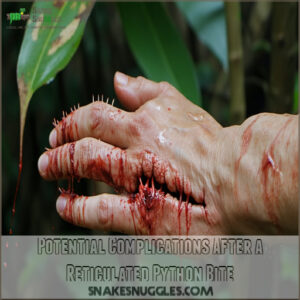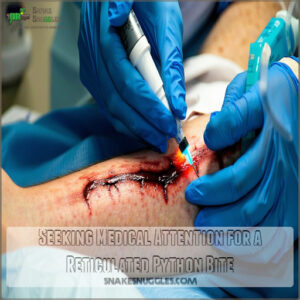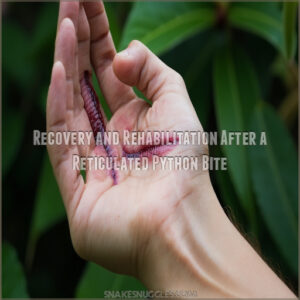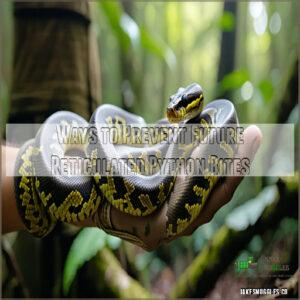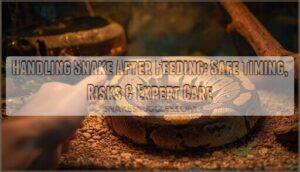This site is supported by our readers. We may earn a commission, at no cost to you, if you purchase through links.

Its sharp, curved teeth puncture the skin in a semicircular pattern, causing immediate pain, bleeding, and possible swelling or bruising.
Since these snakes use their bite to grip prey, the wound may tear, increasing the risk of infection or scarring.
Always clean the bite with soap and water right away, apply pressure to stop bleeding, and head to a doctor for evaluation.
Complications like nerve or tendon damage can happen, so don’t ignore it.
While pythons bite defensively, knowing how to react can keep you safe and healthy.
Table Of Contents
- Key Takeaways
- What Happens When a Reticulated Python Bites You?
- Understanding The Severity of a Reticulated Python Bite
- Is The Reticulated Python Bite Venomous?
- Potential Complications After a Reticulated Python Bite
- What to Do Immediately After a Reticulated Python Bite
- Seeking Medical Attention for a Reticulated Python Bite
- Treatment for a Reticulated Python Bite
- Recovery and Rehabilitation After a Reticulated Python Bite
- Ways to Prevent Future Reticulated Python Bites
- Frequently Asked Questions (FAQs)
- What happens when a reticulated python bites you?
- How painful is a python bite?
- How aggressive are reticulated pythons?
- Is reticulated python venomous?
- Which snake has the most painful bite?
- What should I do if my python bites me?
- How strong is a reticulated pythons bite force?
- Can a reticulated pythons bite sever limbs?
- Do reticulated pythons release their bite voluntarily?
- Are there long-term psychological effects from python bites?
- Conclusion
Key Takeaways
- A reticulated python’s bite isn’t venomous but can cause pain and infection, so clean the wound and seek medical care right away.
- Its sharp, curved teeth leave a semicircular injury pattern, often leading to bleeding and swelling, and potential tissue or nerve damage.
- Always stay calm and remove the snake carefully to avoid worsening injuries, then stop the bleeding and properly treat the wound and tissue.
- Prevent bites by using secure enclosures, handling the snake calmly, and avoiding sudden movements or handling during feeding times.
What Happens When a Reticulated Python Bites You?
When a reticulated python bites, it’s a jarring experience that demands attention.
These non-venomous snakes use hundreds of sharp, backward-facing teeth to latch onto their prey—or your hand.
The bite mechanism delivers an immediate stabbing pain as the teeth puncture your skin, leaving a distinctive semicircular pattern of wounds.
The force of their jaws can cause bruising, swelling, or even tissue damage.
If the bite involves twisting or prolonged contact, it might lead to nerve damage or tendon rupture.
Python attacks are rare, but their bites are no joke.
A reticulated python doesn’t stop at just biting.
Its natural constriction methods are designed for prey capture, though its grip on humans is defensive.
Understanding the bite aftermath helps you respond quickly to lessen the risk of complications and guide effective snake bite treatment.
Understanding The Severity of a Reticulated Python Bite
When faced with a reticulated python bite, you’re dealing with more than just sharp teeth.
These snakes have strong jaws and backward-curving teeth designed to hold prey, often causing puncture wounds and deep lacerations.
Because reticulated pythons are non-venomous, bites rarely cause systemic toxicity, but infection prevention is essential.
The bite force and injury patterns depend on the snake’s size and behavior.
Defensive bites may lead to shallow wounds, while more forceful bites result in crushing injuries or nerve damage.
One key factor in the severity of a python bite is its constriction methods.
Once a snake’s instincts kick in, significant tissue damage, bruising, or swelling can occur, even in brief encounters.
- Bite force often causes punctures and deep wounds.
- Snake behavior during a bite influences injury patterns.
- Constriction methods can worsen soft tissue injuries.
Is The Reticulated Python Bite Venomous?
Although the reticulated python may sound dangerous, its bite is nonvenomous.
Unlike a venomous snake, this python relies on constriction methods, not snake venom, to capture prey.
Its bite mechanics are designed for holding and immobilizing, using sharp, curved teeth.
While you won’t face the dangers of venom, the bite still carries risks.
Puncture wounds and tearing can cause bleeding or lead to infection without proper care.
It’s essential to remember that a python bite is defensive, typically occurring when the snake feels threatened or startled.
This behavior is part of its natural survival instincts.
Understanding the difference between a nonvenomous snake like the reticulated python and venomous snakes can help you approach such situations more calmly and confidently.
Potential Complications After a Reticulated Python Bite
A reticulated python bite mightn’t deliver venom, but it can still lead to serious issues.
One major concern is tissue infection caused by bacteria from the snake’s mouth entering the wound.
Without proper care, it could worsen quickly.
Factors like captive breeding practices can influence the frequency of these bites.
Another risk is nerve damage, which can reduce sensation and movement in affected areas like your hand or arm.
In severe cases, this may require surgery or physical therapy to regain mobility.
Scarring risks are also significant, as deep bites can leave lasting marks that restrict movement.
More severe bites may even involve internal injuries, especially if the snake clamps down or you struggle to pull away.
Complications like blood loss and embedded teeth fragments add to the danger, sometimes requiring surgical removal.
Understanding these bite symptoms and acting quickly can save you from long-term effects.
Preventing bites altogether is always the best way to avoid these risks.
What to Do Immediately After a Reticulated Python Bite
If you’ve been bitten by a reticulated python, stay calm and act quickly.
The right steps can make all the difference in preventing complications.
Here’s what to do in the first moments:
- Free yourself safely: If the snake is still latched on, avoid pulling it off to prevent more injuries. Instead, carefully loosen its grip or get help.
- Control bleeding and clean the wound: Apply gentle pressure with a clean cloth to stop bleeding, but skip tourniquets—they do more harm than good. Wash the wound thoroughly with soap and clean water to minimize infection risk.
- Document the bite: If possible, snap a photo of the snake. It can help with identification during medical care.
Remember, even a non-venomous snake bite requires First Aid. Whether from a wild or pet python, treat the situation seriously to reduce risks from injury or bacteria.
Seeking Medical Attention for a Reticulated Python Bite
Getting prompt emergency care for a reticulated python bite is essential for proper snake bite treatment. Head to a hospital or call an ambulance if necessary. Quick action helps prevent complications like infections or tissue damage.
When you arrive, doctors will:
- Evaluate wound severity and check for damage to nerves, tendons, or blood vessels.
- Assess symptoms, such as pain, numbness, or swelling.
- Ask about the bite, the python’s size, and any first aid measures completed.
Accurate details guarantee the best medical response.
Treatment for a Reticulated Python Bite
Treating a reticulated python bite starts with cleaning the wound and preventing infection. In serious cases, surgery may be needed to fix damaged tissues and reduce complications.
Wound Care and Infection Prevention
Wound care starts with cleaning puncture wounds using warm water and mild soap to reduce infection risk.
For additional products, explore these python bite wound care options.
Apply antibiotic ointment, and follow up with prescribed antibiotics.
Watch for symptoms like swelling, redness, or unusual tissue damage.
Stick to your doctor’s advice to support healing.
Proper wound cleaning and infection prevention stop complications, ensuring your recovery goes smoothly.
Surgical Intervention and Repair
Serious python bites might call for surgical intervention to fix tissue damage, nerve injuries, or bone fractures.
Doctors clean the wound, remove debris, and focus on wound closure.
Tendon repairs, like fixing the EPL, and skin grafts may restore function.
Proper care prevents long-term issues and infection.
Successful tissue repair guarantees you heal fully after this startling wildlife encounter!
Recovery and Rehabilitation After a Reticulated Python Bite
Healing after a reticulated python bite takes time, persistence, and proper care. Once treatment is complete, your focus shifts to recovery and rehabilitation. Reticulated pythons are non-venomous snakes, but their bites can still cause significant injuries.
Recovery times vary, often lasting weeks to months, depending on the severity of the wound. Physical therapy can help restore mobility and strength, especially if tendons or nerves were affected.
Consistent wound care prevents infection, while scar management methods—like silicone sheets or massage—can minimize visible marks. Start with gentle exercises to reduce stiffness, then slowly increase activity as pain subsides. Listen to your body; overdoing it can delay healing.
Remember, recovery isn’t just physical. Emotional trauma is common after such incidents. Feeling anxious around snakes or in similar environments is normal. Seek support if needed to address these feelings. With patience and long-term care, including pain management and steady progress, you’ll overcome this challenging experience, feeling stronger and more resilient.
Ways to Prevent Future Reticulated Python Bites
Protecting yourself from a reticulated python bite involves understanding snake behavior and adopting practical safety measures.
You can find suitable reticulated python cages online. Use secure Snake Enclosures to prevent escapes. During Reptile Handling, wear Protective Gear like gloves and long sleeves. Avoid triggering bites by handling them calmly and skipping feeding times.
Here’s a quick guide:
| Action | Why It Matters | Result |
|---|---|---|
| Use Escape-Proof Cages | Keeps snakes contained | Enhances Bite Prevention |
| Avoid Sudden Movements | Reduces perceived threat | Safer Python Handling |
| Have Help Nearby | Extra support during handling | Boosts Emergency Preparedness |
Follow these steps for python bite prevention.
Frequently Asked Questions (FAQs)
What happens when a reticulated python bites you?
When a reticulated python bites, its sharp teeth create deep puncture wounds, often in a semicircular pattern.
You’ll feel pain, see bleeding, and risk infection.
Immediate cleaning, bandaging, and medical care are essential.
How painful is a python bite?
A python bite feels sharp and intense, like dozens of tiny needles piercing your skin.
You’ll experience immediate pain, bleeding, and swelling.
While non-venomous, their strong jaws and curved teeth can cause deep, lasting punctures.
How aggressive are reticulated pythons?
It’s interesting how such stunning creatures have a cautious side.
Reticulated pythons aren’t naturally aggressive but can become defensive if startled or threatened.
Give them space, approach calmly, and they’ll typically remain peaceful.
Is reticulated python venomous?
No, reticulated pythons aren’t venomous.
Instead, they rely on strong jaws and sharp teeth to seize prey and powerful muscles to constrict.
While bites can hurt, they don’t inject venom, so infection risks matter more.
Which snake has the most painful bite?
The saw-scaled viper delivers one of the world’s most painful bites, described as intense burning.
Its venom causes severe swelling, blistering, and tissue damage.
Immediate medical help is imperative to prevent serious complications and its venom’s effects, such as tissue damage.
What should I do if my python bites me?
Stay calm and gently remove the snake.
Clean the bite with soap and water, apply a clean bandage, and elevate the area.
Seek medical attention quickly to prevent infection or address potential injuries.
How strong is a reticulated pythons bite force?
Imagine a jaw filled with sharp, backward-curving teeth clamping down with remarkable precision.
A reticulated python’s bite force isn’t as strong as its constriction but can easily puncture skin, causing significant tissue damage and bleeding.
Can a reticulated pythons bite sever limbs?
A reticulated python’s bite can’t sever limbs, but its teeth can cause deep puncture wounds, tissue damage, and significant bleeding.
Coupled with constriction, it can inflict serious harm, so always handle them with extreme care.
Do reticulated pythons release their bite voluntarily?
Reticulated pythons don’t usually release their bite voluntarily.
Their backward-curving teeth grip prey tightly, and they may only let go after restraints are removed or if they feel safe.
Always handle with caution to avoid bites.
Are there long-term psychological effects from python bites?
Getting bitten by a python can feel traumatic and may leave you anxious around snakes.
Long-term effects vary, but some experience lingering fear or stress.
Understanding the incident and seeking support can ease those feelings.
Conclusion
Did you know a reticulated python’s bite can deliver over two dozen puncture wounds at once?
Though it’s not venomous, the bite can still cause serious issues like infection or tendon damage if untreated.
Wash the wound, stop the bleeding, and see a doctor right away for proper care.
Quick action reduces risks and speeds healing. Understanding how to treat a reticulated python bite helps keep you safe and guarantees a smoother recovery.
- https://www.omega.com/en-us/resources/just-how-strong-is-a-python
- https://en.wikipedia.org/wiki/Reticulated_python
- https://pmc.ncbi.nlm.nih.gov/articles/PMC4037439/
- https://www.reptileforums.co.uk/threads/is-it-possible-to-not-get-bit-by-a-reticulated-python-when-its-big-in-its-life-time.1218754/
- https://www.ncbi.nlm.nih.gov/pmc/articles/PMC2850421/



